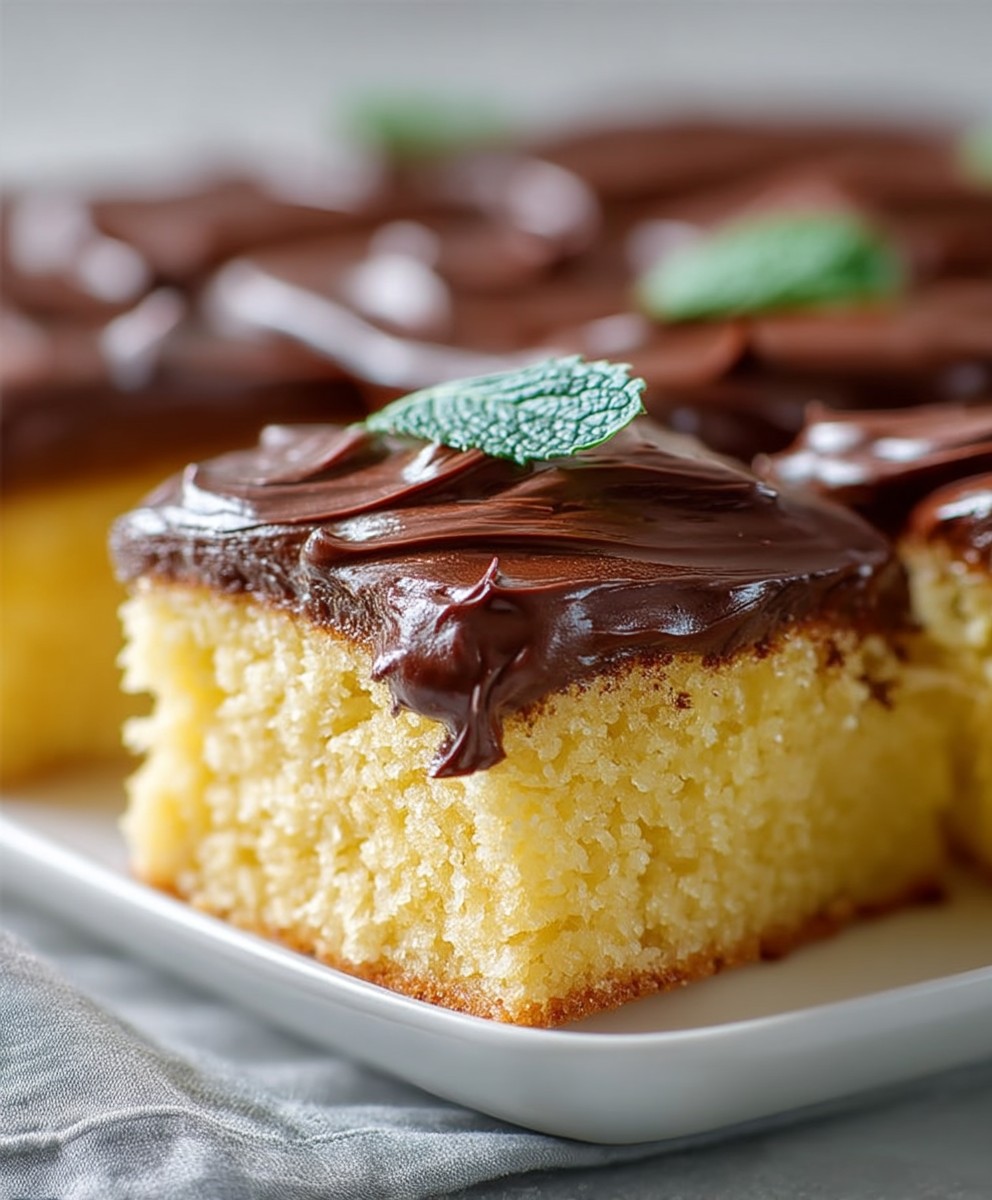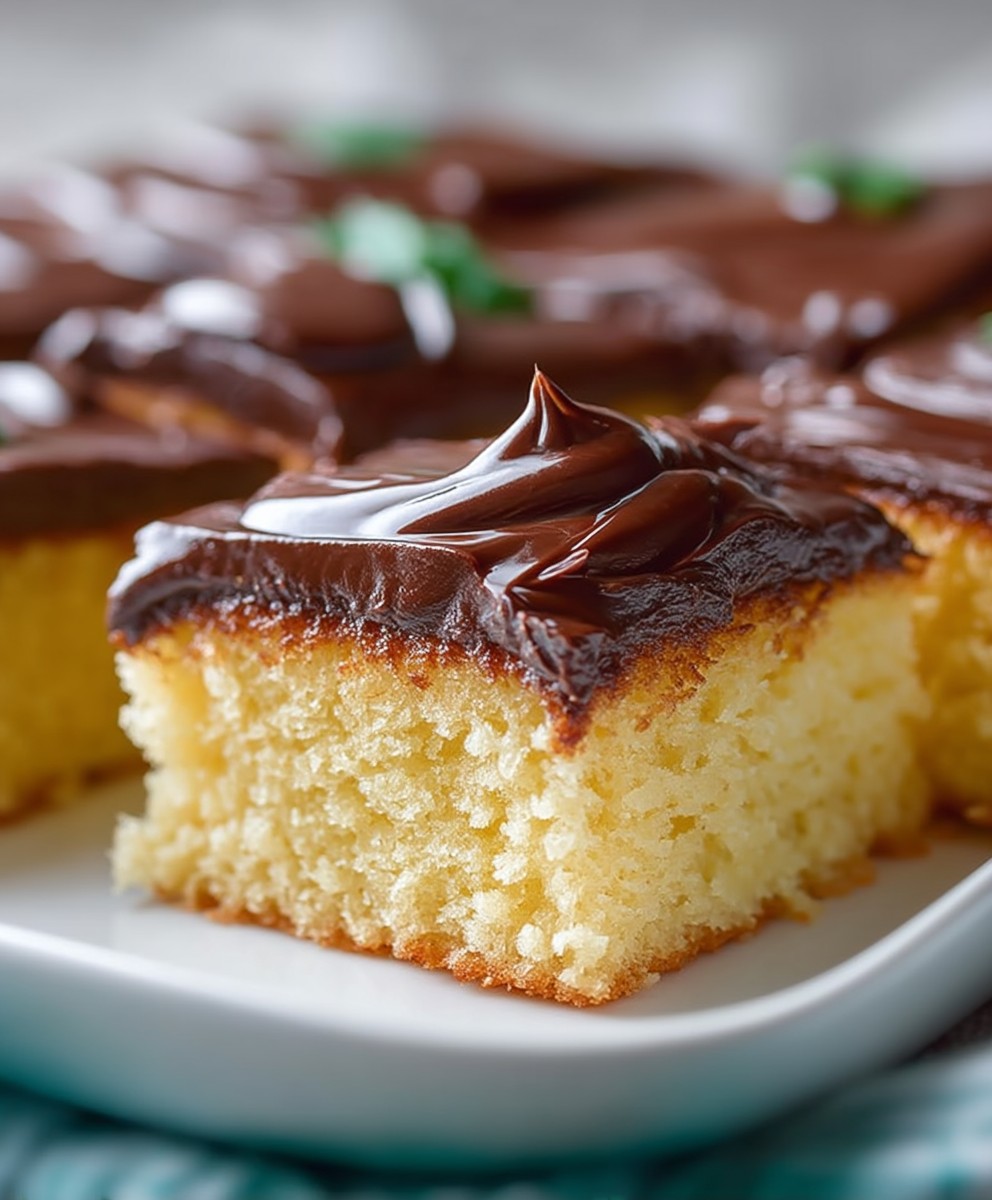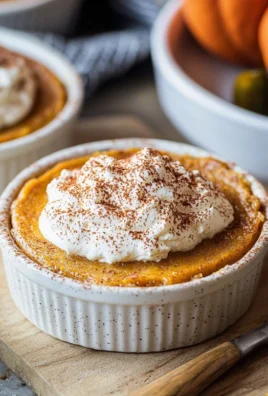Yellow Sheet Cake: just the name conjures up images of sunshine, celebration, and pure, unadulterated joy, doesn’t it? This isn’t just any cake; it’s a nostalgic trip back to childhood birthdays, potlucks overflowing with deliciousness, and the simple pleasure of a homemade treat. I remember my grandmother always making a yellow sheet cake for family gatherings, and it was always the first dessert to disappear!
While its exact origins are shrouded in a bit of mystery, sheet cakes, in general, gained popularity in the mid-20th century alongside the rise of convenient baking ingredients. They were the perfect solution for feeding a crowd without the fuss of elaborate layer cakes. The beauty of a yellow sheet cake lies in its simplicity. It’s a humble dessert, but its flavor is anything but ordinary.
People adore this cake for so many reasons. The tender, moist crumb practically melts in your mouth, and the classic vanilla flavor is universally appealing. It’s incredibly easy to make, requiring minimal effort and readily available ingredients. Plus, the generous size makes it perfect for sharing with friends and family. Whether you top it with a simple chocolate frosting, a tangy cream cheese frosting, or even just a dusting of powdered sugar, a yellow sheet cake is guaranteed to be a crowd-pleaser. So, let’s get baking and create some sweet memories!
Ingredients:
- For the Cake:
- 2 1/2 cups all-purpose flour
- 2 1/2 cups granulated sugar
- 1 teaspoon baking powder
- 1 teaspoon baking soda
- 1 teaspoon salt
- 1 cup (2 sticks) unsalted butter, softened
- 1 cup buttermilk
- 1/2 cup vegetable oil
- 4 large eggs
- 2 teaspoons vanilla extract
- 1 cup boiling water
- For the Frosting:
- 1 cup (2 sticks) unsalted butter, softened
- 6 cups powdered sugar
- 1/2 cup milk
- 2 teaspoons vanilla extract
- Pinch of salt
- Optional: Yellow food coloring (gel is best)
Preparing the Cake Batter:
- Preheat and Prep: First things first, preheat your oven to 350°F (175°C). While the oven is heating, grease and flour a 9×13 inch baking pan. I like to use baking spray with flour already in it it makes things so much easier! Make sure you get into all the corners to prevent sticking.
- Combine Dry Ingredients: In a large bowl, whisk together the flour, sugar, baking powder, baking soda, and salt. Whisking is key here to ensure everything is evenly distributed. You don’t want pockets of baking soda in your cake!
- Cream Butter and Add Wet Ingredients: In a separate large bowl (or the bowl of your stand mixer), cream together the softened butter, buttermilk, and vegetable oil until light and fluffy. This usually takes about 3-5 minutes. The mixture should be smooth and well combined.
- Add Eggs and Vanilla: Beat in the eggs one at a time, making sure each egg is fully incorporated before adding the next. Then, stir in the vanilla extract. Vanilla really enhances the flavor of this cake, so don’t skimp on it!
- Combine Wet and Dry Ingredients: Gradually add the dry ingredients to the wet ingredients, mixing on low speed until just combined. Be careful not to overmix! Overmixing can lead to a tough cake. I usually add the dry ingredients in three additions, mixing until *just* combined after each addition.
- Add Boiling Water: This is the secret ingredient! Carefully pour the boiling water into the batter and mix on low speed until the batter is smooth and thin. Don’t be alarmed by the thin consistency; this is what makes the cake so moist. The batter will be quite liquidy, but that’s perfectly normal.
Baking the Cake:
- Pour into Pan: Pour the batter into the prepared 9×13 inch baking pan, spreading it evenly.
- Bake: Bake for 30-35 minutes, or until a wooden skewer inserted into the center comes out clean. Keep a close eye on it, as baking times can vary depending on your oven. The cake should be golden brown on top.
- Cool Completely: Let the cake cool in the pan for 10-15 minutes before inverting it onto a wire rack to cool completely. It’s crucial that the cake is completely cool before frosting, or the frosting will melt. I know it’s tempting to frost it while it’s still warm, but resist the urge!
Preparing the Frosting:
- Cream Butter: In a large bowl (or the bowl of your stand mixer), cream the softened butter until light and fluffy. This usually takes about 3-5 minutes.
- Add Powdered Sugar: Gradually add the powdered sugar, one cup at a time, mixing on low speed until combined. Be sure to scrape down the sides of the bowl occasionally to ensure everything is evenly mixed.
- Add Milk and Vanilla: Add the milk, vanilla extract, and salt. Beat on medium speed until the frosting is smooth and creamy. If the frosting is too thick, add a little more milk, one tablespoon at a time, until you reach your desired consistency. If it’s too thin, add a little more powdered sugar.
- Add Food Coloring (Optional): If you want a vibrant yellow frosting, add a few drops of yellow food coloring (gel is best) and mix until evenly colored. Start with a small amount and add more until you achieve the desired shade.
Frosting and Serving:
- Frost the Cake: Once the cake is completely cool, frost it with the prepared frosting. I like to start by putting a large dollop of frosting in the center of the cake and then spreading it outwards with an offset spatula.
- Decorate (Optional): If you’re feeling fancy, you can decorate the cake with sprinkles, candies, or other toppings.
- Slice and Serve: Slice the cake into squares and serve. This cake is best enjoyed fresh, but it can be stored in an airtight container at room temperature for up to 3 days.
Tips for the Best Yellow Sheet Cake:
- Use Room Temperature Ingredients: Using room temperature butter, eggs, and buttermilk will help the ingredients emulsify properly, resulting in a smoother batter and a more tender cake.
- Don’t Overmix: Overmixing the batter can develop the gluten in the flour, leading to a tough cake. Mix until just combined.
- Measure Accurately: Accurate measurements are crucial for baking success. Use measuring cups and spoons specifically designed for baking.
- Cool Completely: Make sure the cake is completely cool before frosting to prevent the frosting from melting.
- Adjust Sweetness: If you prefer a less sweet frosting, you can reduce the amount of powdered sugar.
- Buttermilk Substitute: If you don’t have buttermilk, you can make a substitute by adding 1 tablespoon of white vinegar or lemon juice to a liquid measuring cup and then filling the cup with milk to the 1-cup line. Let it sit for 5 minutes before using.
- Storage: Store leftover cake in an airtight container at room temperature for up to 3 days. You can also freeze the cake for longer storage. Wrap it tightly in plastic wrap and then in foil.
Variations:
- Chocolate Frosting: Substitute the vanilla frosting with a chocolate frosting for a chocolate and yellow cake combination.
- Lemon Zest: Add lemon zest to the cake batter for a citrusy twist.
- Sprinkles: Add sprinkles to the batter or on top of the frosting for a festive touch.
- Nuts: Add chopped nuts to the batter or on top of the frosting for added texture and flavor.
Troubleshooting:
- Cake is Dry: Make sure you’re not overbaking the cake. Also, ensure you’re using enough liquid in the batter.
- Cake is Dense: This could be due to overmixing the batter or not using enough leavening agents (baking powder and baking soda).
- Frosting is Too Thick: Add a little more milk, one tablespoon at a time, until you reach your desired consistency.
- Frosting is Too Thin: Add a little more powdered sugar, one tablespoon at a time, until you reach your desired consistency.

Conclusion:
So there you have it! This Yellow Sheet Cake recipe is truly a must-try for so many reasons. It’s incredibly easy to make, even for beginner bakers, and the results are always impressive. The moist, tender crumb combined with the sweet, tangy frosting is a flavor combination that’s simply irresistible. Forget complicated layer cakes that take hours; this sheet cake delivers maximum flavor with minimal effort. It’s the perfect dessert for potlucks, birthday parties, or even just a simple weeknight treat.
But the best part? It’s incredibly versatile! While I’ve shared my go-to frosting recipe, feel free to experiment with different flavors. A chocolate buttercream would be divine, or you could try a cream cheese frosting for a richer, tangier twist. For a more festive look, add sprinkles or chopped nuts. You could even swirl in some fruit preserves into the batter before baking for a burst of fruity flavor.
Serving Suggestions and Variations:
* Classic Slice: Serve it simply, cut into squares, and enjoy with a cold glass of milk or a cup of coffee.
* Celebration Cake: Decorate with frosting swirls, sprinkles, and candles for a birthday or special occasion.
* Fruit Topping: Top with fresh berries, sliced peaches, or a homemade fruit compote for a summery treat.
* Ice Cream Pairing: Serve warm with a scoop of vanilla ice cream for an extra indulgent dessert.
* Chocolate Chip Variation: Fold in chocolate chips into the batter before baking for a chocolatey surprise.
* Nutty Delight: Add chopped pecans or walnuts to the batter or sprinkle on top of the frosting for added texture and flavor.
* Lemon Zest Boost: Add lemon zest to the batter for a brighter, more citrusy flavor.
* Coffee Infusion: Add a tablespoon of instant coffee to the batter for a subtle coffee flavor that complements the sweetness.
I truly believe that this Yellow Sheet Cake will become a staple in your baking repertoire. It’s a crowd-pleaser that’s guaranteed to bring smiles to everyone’s faces. The simplicity of the recipe makes it perfect for those busy weeknights when you need a quick and easy dessert, while the delicious flavor makes it worthy of any special occasion.
Don’t be intimidated by baking; this recipe is foolproof! Just follow the instructions carefully, and you’ll have a beautiful and delicious cake in no time. I’ve tried to make the instructions as clear and concise as possible, but if you have any questions, feel free to leave a comment below.
Now, it’s your turn! I’m so excited for you to try this recipe and experience the joy of baking this amazing Yellow Sheet Cake. Once you’ve made it, please come back and share your experience in the comments below. I’d love to hear about any variations you tried, how your family and friends enjoyed it, and any tips or tricks you discovered along the way. Happy baking, and I can’t wait to hear from you! Let me know if it becomes your go-to recipe like it is for me! I am sure you will love it.
Yellow Sheet Cake: The Ultimate Recipe & Baking Guide
Classic, moist, and tender yellow sheet cake with a creamy vanilla frosting. Perfect for birthdays, potlucks, or any celebration!
Ingredients
- 2 1/2 cups all-purpose flour
- 2 1/2 cups granulated sugar
- 1 teaspoon baking powder
- 1 teaspoon baking soda
- 1 teaspoon salt
- 1 cup (2 sticks) unsalted butter, softened
- 1 cup buttermilk
- 1/2 cup vegetable oil
- 4 large eggs
- 2 teaspoons vanilla extract
- 1 cup boiling water
- 1 cup (2 sticks) unsalted butter, softened
- 6 cups powdered sugar
- 1/2 cup milk
- 2 teaspoons vanilla extract
- Pinch of salt
- Optional: Yellow food coloring (gel is best)
Instructions
- Preheat oven to 350°F (175°C). Grease and flour a 9×13 inch baking pan.
- In a large bowl, whisk together the flour, sugar, baking powder, baking soda, and salt.
- In a separate large bowl (or stand mixer), cream together the softened butter, buttermilk, and vegetable oil until light and fluffy (3-5 minutes).
- Beat in the eggs one at a time, fully incorporating each before adding the next. Stir in the vanilla extract.
- Gradually add the dry ingredients to the wet ingredients, mixing on low speed until just combined. Be careful not to overmix.
- Carefully pour the boiling water into the batter and mix on low speed until the batter is smooth and thin.
- Pour the batter into the prepared 9×13 inch baking pan, spreading it evenly.
- Bake for 30-35 minutes, or until a wooden skewer inserted into the center comes out clean.
- Let the cake cool in the pan for 10-15 minutes before inverting it onto a wire rack to cool completely.
- In a large bowl (or stand mixer), cream the softened butter until light and fluffy (3-5 minutes).
- Gradually add the powdered sugar, one cup at a time, mixing on low speed until combined. Scrape down the sides of the bowl occasionally.
- Add the milk, vanilla extract, and salt. Beat on medium speed until the frosting is smooth and creamy. Adjust milk/powdered sugar for desired consistency.
- Add a few drops of yellow food coloring (gel is best) and mix until evenly colored.
- Once the cake is completely cool, frost it with the prepared frosting.
- Decorate the cake with sprinkles, candies, or other toppings.
- Slice the cake into squares and serve.
Notes
- Use room temperature ingredients for best results.
- Don’t overmix the batter.
- Measure ingredients accurately.
- Cool the cake completely before frosting.
- Adjust sweetness of frosting to your preference.
- Buttermilk Substitute: 1 tbsp white vinegar or lemon juice + milk to 1 cup. Let sit 5 minutes.
- Storage: Store leftover cake in an airtight container at room temperature for up to 3 days. Freeze for longer storage.





Leave a Comment